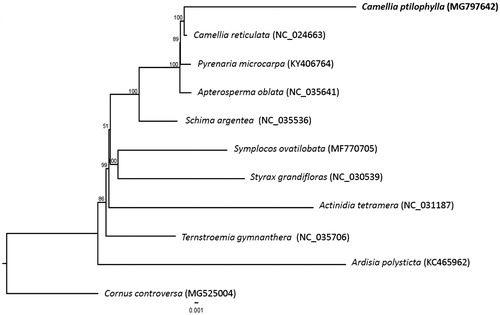Abstract
Camellia ptilophylla is a natural caffeine-free tea plant endemic to China with high commercial and therapeutic values. Here, we report the complete chloroplast genome assembled using Illumina pair-end sequencing data. The chloroplast genome was 157,097 bp in length, with a large single copy (LSC) region of 86,631 bp, a small single copy (SSC) region of 18,286 bp, separated by two inverted repeat (IR) regions of 26,090 bp each. It contains a total of 132 genes, with an overall GC content of 37.3%. The phylogenetic analysis showed that C. ptilophylla is sister to a congeneric species, C. reticulata.
Nowadays, as one of most famous beverages in the world, tea is well known for its extraordinary abilities to promote health. However, like coffee, the caffeine in tea can excite nerves, and overdose of tea could lead to some side effects (Mohanpuria et al. Citation2010). Camellia ptilophylla Chang, commonly referred to as the cocoa tea plant, is a wild tea tree endemic to China that contains theobromine instead of caffeine (Chang et al. Citation1988). Previous studies have also found that cocoa tea has stronger anti-oxidant properties and positive health effects (Peng et al. Citation2010; Li et al. Citation2012). The plant is mainly distributed in the Longmen County, Guangdong Province, China (Chang and Ren Citation1998). In recent years, habitat degradation and loss have resulted in the decrease of population size of the species, further calling for efforts to conserve this valuable wild tea resource. To gain a better insight into its genetics and genomics and thus contribute to its conservation, we assembled and characterized the complete chloroplast genome of C. ptilophylla in this study.
Total DNA was isolated from fresh leaves of an individual of C. ptilophylla, collected from Nankunshan Nature Reserve, Longmen County, Guangdong Province (23°38′5.21′′ N, 113°52′56′′ E). The voucher specimen (Shi XG 171203) was deposited in the Sun Yat-sen University Herbarium (SYS). Genome sequencing was performed on an Illumina Hiseq X Ten platform generating paired-end reads of 150 bp. In total, 5.99 Gb short sequence data were obtained and used to assemble the chloroplast genome using NOVOPlasty (Dierckxsens et al. Citation2017). A partial chloroplast atpB sequence of the congeneric C. leptophylla (GenBank accession number NC_024660) was used as the seed sequence. The genes were annotated using DOGMA (Wyman et al. Citation2004).
The complete chloroplast genome of C. ptilophylla (GenBank accession MG797642) was 157,097 bp in size, containing a pair of inverted repeats (IRs) of 26,090 bp each, separated a large single copy (LSC) region of 86,631 bp and a small single copy (SSC) region of 18,286 bp. The chloroplast genome contained 132 genes, including 90 protein-coding genes, 34 transfer RNA genes, and eight ribosomal RNA genes. Most of the genes occur as single-copy in the LSC or SSC, while 19 gene species had two copies in the IRs. The overall GC content of the chloroplast genome was 37.3%.
Phylogenetic analysis was performed using complete chloroplast genomes from 10 species in the order Ericales including C. ptilophylla, and one species from Cornales (Cornus controversa) as the outgroup species. The chloroplast genome sequences were aligned using MAFFT (Katoh and Standley Citation2013). Phylogenetic analysis using the maximum likelihood algorithm was conducted with RAxML (Stamatakis Citation2014) implemented in Geneious ver. 10.1 (http://www.geneious.com, Kearse et al. Citation2012). The result showed that C. ptilophylla is sister to a congeneric species, C. reticulata, with 100% bootstrap support and all species from the family Theaceae were clustered into a monophyletic group ().
Disclosure statement
The authors declare that there is no conflict of interest regarding the publication of this article. The authors alone are responsible for the content and writing of the paper.
Additional information
Funding
References
- Chang HT, Ren SX. 1998. Theaceae (Theoideae). In: Chang HT, editor. Flora Reipublicae Popularis Sinicae, vol. 49(3). Beijing: Science Press; p. 131.
- Chang HT, Ye CX, Zhang RM, Ma YD, Zeng P. 1988. A discovery of new tea resource – cocoa tea tree containing theobromine from China. Acta Sci Nat Univ Sunyatseni. 3:131–133.
- Dierckxsens N, Mardulyn P, Smits G. 2017. NOVOPlasty: de novo assembly of organelle genomes from whole genome data. Nucleic Acids Res. 45:e18.
- Katoh K, Standley DM. 2013. MAFFT multiple sequence alignment software version 7: improvements in performance and usability. Mol Biol Evol. 30:772–780.
- Kearse M, Moir R, Wilson A, Stoneshavas S, Cheung M, Sturrock S, Buxton A, Cooper A, Markowitz S Duran C, et al. 2012. Geneious Basic: an integrated and extendable desktop software platform for the organization and analysis of sequence data. Bioinformatics. 28:1647–1649.
- Li KK, Shi XG, Yang X, Wang YY, Ye CX, Yang ZY. 2012. Antioxidative activities and the chemical constituents of two Chinese teas, Camellia kucha and Camellia ptilophylla. Int J Food Sci Technol. 47:1063–1071.
- Mohanpuria P, Kumar V, Yadav SK. 2010. Tea caffeine: metabolism, functions, and reduction strategies. Food Sci Biotechnol. 19:275–287.
- Peng L, Khan N, Afaq F, Ye CX, Mukhtar H. 2010. In vitro, and in vivo, effects of water extract of white cocoa tea (Camellia ptilophylla) against human prostate cancer. Pharm Res. 27:1128–1137.
- Stamatakis A. 2014. RAxML version 8: a tool for phylogenetic analysis and post-analysis of large phylogenies. Bioinformatics. 30:1312–1313.
- Wyman SK, Jansen RK, Boore JL. 2004. Automatic annotation of organellar genomes with DOGMA. Bioinformatics. 20:3252–3255.

